Our pounds and shelters are full of excellent, but misunderstood dogs. By misunderstood I mean most dogs are in the pound because they had owners who could not speak dog. These owners who didn't give the dog what it instinctually needed created a dog with issues. The two main reasons a dog develops issues are lack of exercise and lack of leadership.
Humans forget they are dealing with a canine animal and too many times do not give the canine what it needs as that animal; when the dog does not act like that picture-perfect image they had in their minds they assume they "didn't get a good one" and they "get rid" of the dog. That's the bad news. The good news is since dogs live in the moment—meaning they do not dwell in the past or think of the future—it is absolutely possible to take a full grown dog and start over as if it is the first day of the rest of its life. If you do it right, you will see a totally different dog from the owners who dumped the dog at the pound saw.

"This is Simi-Anna our Golden Sheltie mix. We rescued her from a shelter here in St. Louis, Missouri. She is a big part of our family. Isn't she beautiful!"
Your first task is to find the right dog. This is going to take time on your part, and should begin before you even set foot in a shelter. Not every dog is a match for every human family. Decide what size dog you would like. Study the different breeds so when you get to the pound you have a general idea of what a wide variety of breeds are like. There are two main things you should look for: the dog's energy level and the dog's dominancy level. By studying a wide variety of breeds before you get to the pound or shelter you should be able to make a more educated guess as to what type of dog will work for you.
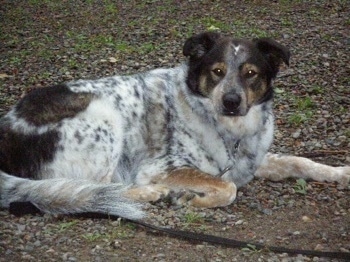
"Here is our dog named Dallas, a cross between a Border Collie and Blue Heeler. He is a rescued dog from the shelter in Canada."
For example, if you see a Rhodesian Ridgeback mix and you studied up on this breed you will know that it will be high energy and needs a more dominant owner. You should choose a dog with the same or lower energy level than your own. You also need to take a serious look at your family's personality. Are you the laid-back, not very active type or are you more authority-driven and active? If your family is passive, a dominant dog would be a horrible match for you. If your family is more assertive and can easily provide structure you may be able to handle a more dominant type. If you are a laid-back, like to watch TV type of family then choosing a very high energy dog that needs to go on daily jogs would not be a good match for you.
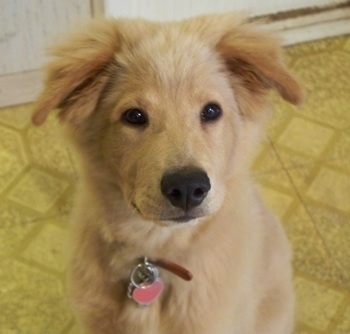
"This is Cisco, our Golden Retriever / Chow Chow mix, who we adopted from a rescue. He is just 6 months old and is loving, energetic, obeys commands, and is very sociable."
After you have a good general idea of what types of dogs will work for you and everyone in the house is in agreement about adopting a dog, it is time to start looking at different pounds and rescues for the right match. Do not think that you need to come home with a dog on the first day. If you choose poorly and bring home a dog that does not match your family you may hurt the dog you are trying to save more than you are helping it. Dogs that are repeatedly returned to the pound have a higher rate of being killed. Take your time and choose wisely.
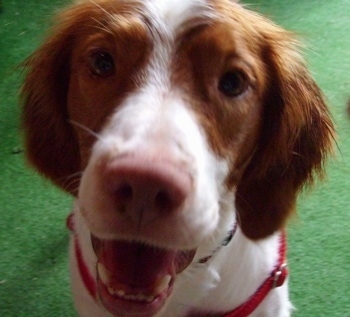
"This is my purebred Brittany Spaniel, Ace. We rescued him from the PSPCA of Danville, PA and we have fallen in love with him ever since!"
Going back to the two primary reasons why dogs are given up for adoption (lack of exercise and leadership) keep in mind that most of these dogs are going to have bottled up energy that they need to burn off. Take a dog that is lacking in exercise and then put it in a small cage for a few days and its stress level is going to be high.

I once spoke with a man who went to the pound to look at the dogs. He had reached his hand out to let a dog smell him and the dog growled. I explained that if he was stiff, facing head on, looking the dog in the eyes, and reaching forward, this is a challenge in dog language. He needed to approach with his body to the side and not to reach forward with eye contact. That is how you greet a dog in the pound behind a cage. It's the friendly way one dog greets the other. You as the human are going to need to learn how to "speak dog." When greeting a dog behind a cage turn your body sideways and do not look him in the eyes. Allow him to smell you through the cage at his leisure. Do not put your fingers through the openings of the cage. Be calm. Dogs are able to feel your emotions and they do not read human emotion the same way humans do. A very important point to remember when adopting a rescue dog is not to feel sorry for the dog—not while you are standing there in the pound and not after you bring the dog home. Dogs interpret the emotion of pity as weakness. Read "The Human Dog" to better understand this concept.
After you have chosen a dog and done the paperwork, it is time to leave the pound with your new friend. There are some key actions that will set you up for either success or failure; the choice is yours.
Refrain from giving the dog hugs and kisses at this time. You have a mission for the day and the more successful you are, the more hugs and kisses you will later be able to give your new friend. To a human a hug is affection. It symbolizes love. For a dog, however, a hug is not love at all; a hug symbolizes dominance and invasion of space. By hugging your dog, you will be invading his space by wrapping your body on top of his before he has gotten the chance to know you and before he has gotten the chance to figure out his place in this new pack. Even if this particular dog does not seem to mind your hugs and kisses, in order to properly ease the dog into their new life you must act like a dog and refrain from your human affection until you communicate some key rules and boundaries to your new family member. This will lessen the stress level for the dog and possibly prevent a bite due to a lack of human-canine communication.
Do not go straight home with your new family member. You need to walk your dog before you bring it home to burn off some of that energy and establish yourself as the leader of the pack in your dog's new life BEFORE you get to your house. When I say “walk the dog,” most people picture themselves with a lead in their hands and the dog walking in front of them. Most people walk their dogs this way and guess what? Most dogs believe they are higher in the pack order than the humans. This explains our huge pet overpopulation problem. The humans need to "Speak Dog", because dogs cannot learn to speak human. You need to get into your dog's mind and communicate with him that he is no longer alpha over humans. Therefore you MUST make your dog heel on the lead without pulling and you MUST go through all entrances and exits such as doorways and gates before the dog—not just on this first day, but from this point forward. In a dog's mind, the leader leads the way. If you allow your dog to go ahead of you, then, whether you realize it or not, you are communicating to the dog that he is YOUR leader. Read "The Proper Way to Walk a Dog".
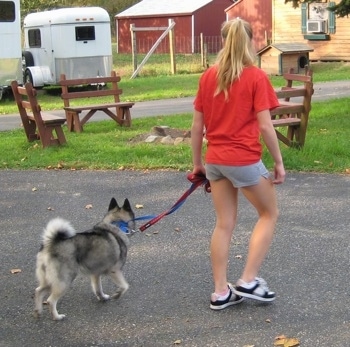
Do not go straight home. Take your new dog for a nice long walk, longer than normal as he will have extra energy he will need to burn off. Walking him as soon as you leave the pound is best. If this is not possible, then drive somewhere you can take him for a walk. You will also need to walk your own neighborhood or surrounding area if you don't have a neighborhood, showing them this new area. You are mimicking the migration instinct in the dog. Driving in the car is not going to do this for the dog. He must walk, heeling on the lead. If you just adopted a small dog do not carry the dog. He must walk just like the big dogs. He may be small but he is still a canine animal with the same instincts. If you own other dogs you need to walk all of the dogs together, heeling on the lead without pulling before you bring the new dog home in order to establish them as one pack.
After your long walk, do not walk in your front door, unsnap the lead and allow the dog to investigate your home. Why, you ask? Because we are "thinking dog". If you unsnap the lead and allow the dog to investigate your home the dog will instinctually run from room to room and claim each room as his own. Remember that there is a good chance the dog was in the pound because he believed he was alpha over his prior family. In order for you to more easily correct his way of thinking, from day one you have to start fresh—new rules for his new life. In the canine world the leader of the pack not only goes first, but he owns everything and gets the best of everything. The leader then allows the rest of his pack to use its things when the leader wishes, and tells them when to eat and where to sleep and where not to go. The rest of the subordinates in the pack happily follow the alpha's wishes. Some humans may think this sounds harsh and mean, however we are not dealing with humans; we are dealing with canine animals and must think like them. Dogs that are not given clear structure and rules are not secure, happy dogs. In order for a dog to be secure it must clearly know who is running the show. It is either going to be you or him. Chances are that in your dog's past life it was him; now it is time for it to be you. If you clearly communicate this to your dog he will be secure and happy in his new life.
When entering your home, be sure all humans enter and exit all gateways, porches and doorways before the dog. The dog should still be on a lead at this time and should be heeling beside or behind the human holding the leash. (The only time a dog on a lead should be out in front is if you are allowing it to go to the bathroom.) At this time it is important that no one comes running up to the dog with hugs, kisses, sweet words, pets, etc., including the kids. As hard as it is going to be, the whole family needs to act like dogs. That means allowing the dog to smell you, but not talking to the dog. A calm, quiet atmosphere where you are introducing the dog to his new den will return huge dividends in the future. Do not invite a huge crowd of neighbors over to greet your new dog just yet. Your dog needs to get to know you before he is mobbed by humans. The only people who should be allowed to this introduction are those who understand how to speak dog.
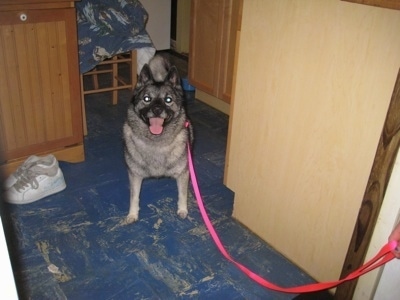
While keeping him on a lead, take your dog to the entranceway of each room he will be allowed in. Make sure the humans enter the room before the dog. If there is a room your dog will not be allowed to enter, do not take your dog into that room; only introduce him to rooms he will be allowed to be in. Having a room or area of the house a dog is not allowed to enter is a great way to establish a boundary. Dogs instinctually need boundaries, as it is another thing the alpha dog would establish with the lower members of his pack—where they can and cannot go.
After the dog has stood in the room for at least 10 minutes (longer is fine), while still on the lead walk him around the room and allow him to smell it. Move onto the next room, stopping at the entrance to allow all humans to pass into the next room before the dog. Do this in each room the dog will be allowed in.
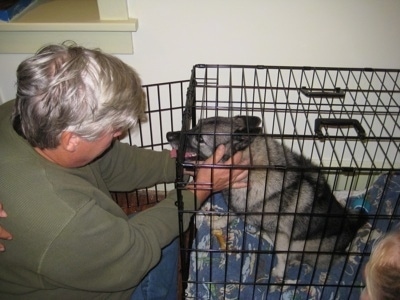
Have a place already set up for your dog, whether a crate or a dog bed. Show this place to your dog. Allow him to smell it. Place a dog bone or some treats on his new place so your dog associates this place with something positive. If your dog is acting calm and is not showing signs of wanting to be the leader you may rub his head, neck and/or back. Do not snuggle down into the dogs face at this time, as you are still establishing the new order. If your dog is not calm you may need to walk him longer. Do not pet him if he is hyper or not listening to you. Always keep in mind that as dogs do not yell and scream, nor should the humans. Every human around the dog should firm, but very calm.
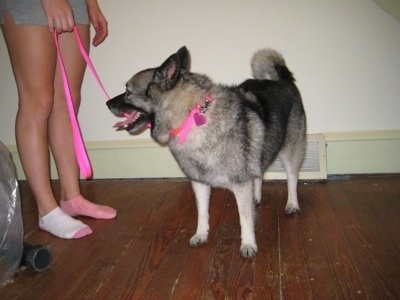
How will you know when it is OK to pet your dog? When the dog is submissive and acting calmly, holding his head low, ears relaxed and slightly back. The dog might curl into a circle. Basically he will make himself smaller, telling you he does not wish to be boss. If your dog lowers his head and turns away from you he is not sad. Remember that direct eye contact to a dog in a dominant frame of mind is a challenge, and if your dog used to be the leader of his prior family and he is now not making eye contact with you, then chances are he is trying to tell you that you may have the leadership position, as he is giving it up.
Do not pet the dog if he is excited, scared, nervous, anxious, nor when he is showing signs of dominance by being very perky and proud, asking you for attention. A dog that is asking to be petted is demanding that you do something for him. A demand from a dog is an alpha behavior. Ways to recognize alpha behavior in your dog are if he’s carrying himself proudly with a stance that makes him look bigger. He will also have his ears perked. When dogs carry themselves like this they look beautiful, but in the dog world it is a dog trying to puff themselves out for the role of the leader. Dogs should not be petted or sweet-talked when they display this behavior.
When a dog shows signs of dominance, the dog should receive no affection until you are able to make him realize he is not the boss and he accepts it by acting submissively. The more submissive and stable-minded the dog gets, the more love you can give him. Dogs should not get any affection until the dominance is under control. Your affection will reinforce whatever mind-frame (in human words, ”mood") the dog is in.
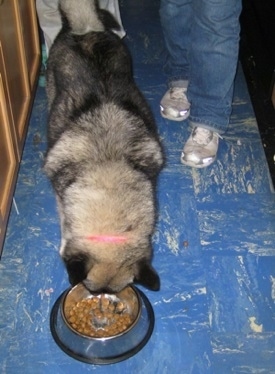
Give your dog something to eat, and walk him out to go to the bathroom (water should always be offered throughout the day). Food should be offered after the dog has cooled down from his long walk, not before, mimicking the instinct for a dog to work for his meal. If you have a fenced-in yard, walk the dog on the lead, making him heel as you show him the yard. The first time your dog sees your yard do not just set him free to explore because you do not want the dog to claim the yard; it is YOUR yard and you are going to allow him to be in it. This is speaking dog. If we were speaking human we would tell the other human to "make themselves at home" and allow them to walk around as they wished. However we are speaking to a canine animal and must speak canine to the canine, not human to the canine. If you think there is a chance your dog has to go to the bathroom you may introduce him to the yard before the house. The order of introduction is not important, but the way you introduce is critical.
This next point is going to be a hard one for most families, especially those with kids. For the next several days you must refrain from the hugs and kisses until the dog is 100% clear that all humans, including the kids, are higher in the order than he is.
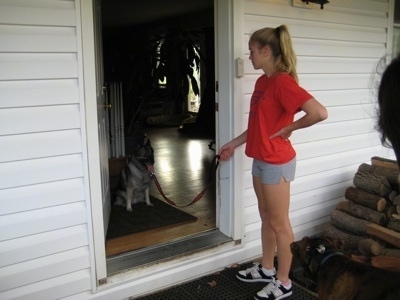
From this point forward the dog will need daily walks where he heels on the lead. Remember the concept of humans entering and exiting entranceways before the dog. The dog must stand back while humans open and close doors even if there is a fenced yard on the other side. The dog can only go when you say he can. If you do have a door leading to a safe, fenced-in yard it makes a perfect training place. Open the door that leads to the outside and make the dog stay. You can even take a step outside as you are telling the dog to stay. If you think there is a chance he might bolt, snap a leash on him. If you allow him to bolt he would have just won a dominance battle with you. Practice this at gateways while the dog is on a long lead.
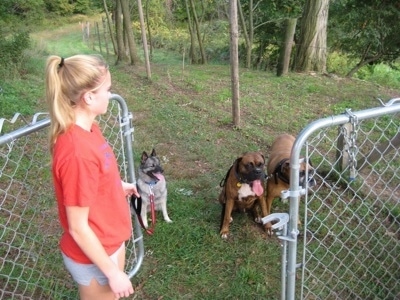
These are just some of the things you can do to communicate to a dog that humans are alpha over them in a way dogs can understand.
Taking the time to "speak dog" will make all the difference in your relationship with your dog, as opposed to the failed one the prior owners had with the dog. A dog that was one person's worst nightmare can be the best thing that ever happened to you. Exercise, canine understanding and communication are the keys to success.

The more successful you are at communicating structure to your dog, along with enough exercise, the more submissive and calmer he will become, which means the more love you can give back to him.
For more examples and tips please read the following:
Amazing what a little leadership can do to a dog's behavior!
SPCA (Society For The Prevention of Cruelty to Animals) (Read these stories)
Written by Sharon Rose© Dog Breed Info Center® All Rights Reserved